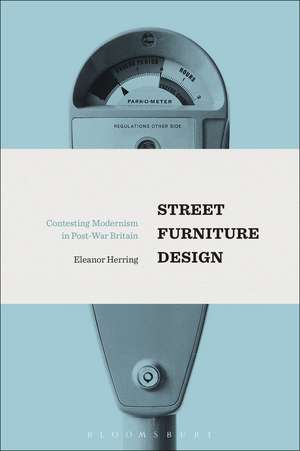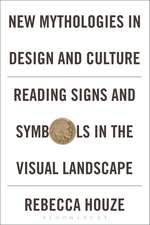Street Furniture Design: Contesting Modernism in Post-War Britain
Autor Eleanor Herringen Limba Engleză Paperback – 27 dec 2017
| Toate formatele și edițiile | Preț | Express |
|---|---|---|
| Paperback (1) | 198.57 lei 6-8 săpt. | |
| Bloomsbury Publishing – 27 dec 2017 | 198.57 lei 6-8 săpt. | |
| Hardback (1) | 537.37 lei 3-5 săpt. | +21.69 lei 10-14 zile |
| Bloomsbury Publishing – 13 iul 2016 | 537.37 lei 3-5 săpt. | +21.69 lei 10-14 zile |
Preț: 198.57 lei
Preț vechi: 244.17 lei
-19% Nou
Puncte Express: 298
Preț estimativ în valută:
38.00€ • 39.53$ • 31.37£
38.00€ • 39.53$ • 31.37£
Carte tipărită la comandă
Livrare economică 12-26 aprilie
Preluare comenzi: 021 569.72.76
Specificații
ISBN-13: 9781350044814
ISBN-10: 1350044814
Pagini: 226
Ilustrații: 60 bw illus.
Dimensiuni: 156 x 234 x 17 mm
Greutate: 0.38 kg
Ediția:NIP
Editura: Bloomsbury Publishing
Colecția Bloomsbury Academic
Locul publicării:London, United Kingdom
ISBN-10: 1350044814
Pagini: 226
Ilustrații: 60 bw illus.
Dimensiuni: 156 x 234 x 17 mm
Greutate: 0.38 kg
Ediția:NIP
Editura: Bloomsbury Publishing
Colecția Bloomsbury Academic
Locul publicării:London, United Kingdom
Caracteristici
Taps into current interest and debate about the design of our shared living places and spaces and the role of national and local government in delivering 'good' design
Notă biografică
Eleanor Herring lectures in design history at the Glasgow School of Art, Scotland. She has published articles in various edited volumes and conference proceedings.
Cuprins
Introduction1. Precedents and Beginnings: 1814 - 19442. The Council of Industrial Design: Official Articulations of Street Furniture Design3. The Great and the Good: Power and Influence4. Municipal Vandalism: Tyranny, Confrontation and Resistance5. Beyond Good Design: A Period of Transformation 1960 - 1974ConclusionEpilogue
Recenzii
[Herring] has done an enormous amount of research to uncover the story of objects that most of us walk past without a second glance. ... [A] fascinating book.
The book includes a useful select bibliography, is appealingly designed and is generously illustrated ... Street Furniture Design: Contesting Modernism in Post-War Britain is an important account of an overlooked chapter in post-war design history, which also demonstrates that design histories can-and should-include multiple voices.
A fascinating and revealing analysis of the controversies and anxieties that surrounded the design of urban environments in post-war England. Using archival and other contemporary accounts, Herring demonstrates how the interplay between a wide array of different players and their contrasting agendas based on class, politics and power, formed and controlled the design of these public spaces.
Meticulously researched and beautifully written, Street Furniture Design delves into the debates about the aesthetics and ethics of British townscapes in the immediate postwar decades. Eleanor Herring has written a scintillating book about how the often unnoticed world of lampposts, benches and bus shelters gets fashioned. It's a great read.
Street Furniture Design sheds a clear light on how taste, class and power impact the relationship between public policy and design. Its thorough research presents compelling evidence about the politics of furnishing the street and the privatization of public space. Eleanor Herring has provided a deep and original insight into the way design meets society. You'll see the street differently now.
A brilliant and entertaining account of a neglected subject, well written, often comic but fundamentally serious history of an important battleground in the war for Good Modern Design in the 20th Century. This will surely become the standard work.
"Street furniture", once central to debates about good design and town planning, has here been treated properly by a meticulous scholar who understands the significance of the subject for design history as a whole. Concentrating on the post war period in Britain, Herring uses street furniture as a lens to elucidate some of the key debates about design and modern urban life. This is an excellent book.
As Eleanor Herring eloquently demonstrates, the superficially banal realm of parking meters, street signage and concrete lamp posts was a significant cultural faultline in post-war Britain... Street furniture provides a useful historic point of contention, she argues, through which to examine their competing claims to public authority and the resultant patterns of acquiescence or revolt. She insightfully explores the rival agendas of government departments, state sponsored design organisations, self-appointed pressure groups and local authority officials, and deftly traces the dynamic interplay of ideology and pragmatism, intransigence and compromise....The structure of Herring's book introduces each organisation in turn through a series of distinct discussions. This allows her to chart in some depth their motives and intellectual approaches... Herring really gets into her stride, however, when she explores a succession of case-study conflicts over particular objects or local installations. Then the discordant chorus of competing professional voices is heard in all its complexity, and the results are generally very impressive....Street Furniture Design is uncommonly good to look at. Its sixty images are superbly chosen, lovingly reproduced, and together comprise a gorgeous scrapbook of post-war public design culture. There are some especially handsome portraits of litter bins, a lovely rogues' gallery of supposedly offensive parking meters, and some evocative deserted streetscapes sharply pierced by an elegant or frumpy lamp post. In documenting these historical conversations and campaigns, Herring stays faithful to the conceptual templates of the organisations she studies....My favourite anecdote in the whole book (and there are a great many to choose from) concerns Norwich City Council, which tested the effects of prospective street lights on the colour of women's make-up before making its decision in... As a detailed exploration of the work of these bodies, their competing ideologies and the fallout of their oft-locked horns, Herring's Street Furniture Design is an enlightening book which has much to tell us about the contested visual meanings of everyday urban objects.
The book includes a useful select bibliography, is appealingly designed and is generously illustrated ... Street Furniture Design: Contesting Modernism in Post-War Britain is an important account of an overlooked chapter in post-war design history, which also demonstrates that design histories can-and should-include multiple voices.
A fascinating and revealing analysis of the controversies and anxieties that surrounded the design of urban environments in post-war England. Using archival and other contemporary accounts, Herring demonstrates how the interplay between a wide array of different players and their contrasting agendas based on class, politics and power, formed and controlled the design of these public spaces.
Meticulously researched and beautifully written, Street Furniture Design delves into the debates about the aesthetics and ethics of British townscapes in the immediate postwar decades. Eleanor Herring has written a scintillating book about how the often unnoticed world of lampposts, benches and bus shelters gets fashioned. It's a great read.
Street Furniture Design sheds a clear light on how taste, class and power impact the relationship between public policy and design. Its thorough research presents compelling evidence about the politics of furnishing the street and the privatization of public space. Eleanor Herring has provided a deep and original insight into the way design meets society. You'll see the street differently now.
A brilliant and entertaining account of a neglected subject, well written, often comic but fundamentally serious history of an important battleground in the war for Good Modern Design in the 20th Century. This will surely become the standard work.
"Street furniture", once central to debates about good design and town planning, has here been treated properly by a meticulous scholar who understands the significance of the subject for design history as a whole. Concentrating on the post war period in Britain, Herring uses street furniture as a lens to elucidate some of the key debates about design and modern urban life. This is an excellent book.
As Eleanor Herring eloquently demonstrates, the superficially banal realm of parking meters, street signage and concrete lamp posts was a significant cultural faultline in post-war Britain... Street furniture provides a useful historic point of contention, she argues, through which to examine their competing claims to public authority and the resultant patterns of acquiescence or revolt. She insightfully explores the rival agendas of government departments, state sponsored design organisations, self-appointed pressure groups and local authority officials, and deftly traces the dynamic interplay of ideology and pragmatism, intransigence and compromise....The structure of Herring's book introduces each organisation in turn through a series of distinct discussions. This allows her to chart in some depth their motives and intellectual approaches... Herring really gets into her stride, however, when she explores a succession of case-study conflicts over particular objects or local installations. Then the discordant chorus of competing professional voices is heard in all its complexity, and the results are generally very impressive....Street Furniture Design is uncommonly good to look at. Its sixty images are superbly chosen, lovingly reproduced, and together comprise a gorgeous scrapbook of post-war public design culture. There are some especially handsome portraits of litter bins, a lovely rogues' gallery of supposedly offensive parking meters, and some evocative deserted streetscapes sharply pierced by an elegant or frumpy lamp post. In documenting these historical conversations and campaigns, Herring stays faithful to the conceptual templates of the organisations she studies....My favourite anecdote in the whole book (and there are a great many to choose from) concerns Norwich City Council, which tested the effects of prospective street lights on the colour of women's make-up before making its decision in... As a detailed exploration of the work of these bodies, their competing ideologies and the fallout of their oft-locked horns, Herring's Street Furniture Design is an enlightening book which has much to tell us about the contested visual meanings of everyday urban objects.










